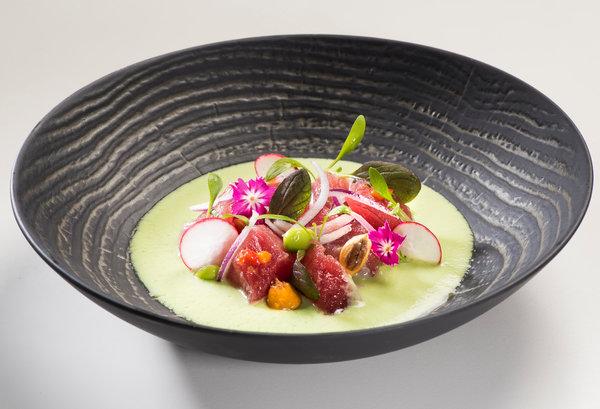Bites
Kampai, the Peruvian chef Cecilia Zapata’s new restaurant in the Swiss city, celebrates Nikkei cuisine, the juncture of Peruvian and Japanese cuisines, to great effect.

The tuna wasabi ceviche at Kampai in Geneva blends Japanese and Peruvian ingredients, the essence of Nikkei cuisine.CreditCreditCorinne Sporrer/Simple Plus
By Sylvie Bigar
When the Peruvian chef Cecilia Zapata opened Kampai in 2017 in Les Paquis, the red light district of Geneva, she was already known as a pioneer and advocate for her native country’s cuisine. An evolution toward what she calls “new Peruvian” cuisine began at Pachacamac, her first restaurant (a second branch opened recently near the Jet d’Eau, the city’s monumental fountain), and continues at Kampai, where she incorporates Nikkei cuisine (a fusion of Peruvian and Japanese influences) and creative pisco-based cocktails.
It’s also a family affair: Ms. Zapata comes from a line of restaurateurs and works with a few of her nine siblings.
“We never thought that we would be working in restaurants,” she said. “Our parents owned eateries in Peru, and we all hated that. We never saw them.”
But when she arrived in Switzerland in 2005, she craved the tangy taste of her mother’s ceviche, the perfumed heat of aji amarillo, and sweet lucuma ice cream. One brother, Cesar, opened a bar, and the family was soon back in the restaurant business.
“Kampai? It’s us,” said another brother, Oscar, the interior designer who created the chic bi-level restaurant and lounge. Cesar crafts the delicious sorbets and ice creams. A sister, Patricia, imports many of the Peruvian ingredients the chef includes in her dishes.
Though Les Paquis can feel seedy (as seedy as Geneva gets, anyway) — my 14-year-old son and I dodged a phalanx of fishnet-clad ladies during a recent visit — once inside, Kampai felt sophisticated and serene. Grey is the dominant color of the décor (as well as the waiters’ leather aprons), but the eye immediately darts to the colorful painted face of an Inca in poncho and chullo, the iconic Peruvian hat.
Throughout, Oscar Zapata shows tremendous attention to detail: Vinyl banquettes are held together by leather belts; the bar is wrapped in the same gray vinyl but its top shines bright red. In the window, three white ceramic planters designed by Mr. Zapata hold orchids. He is also responsible for the Inca-inspired china as well as the wavy, three-dimensional, LED-lit mural representing fish shapes. The same color themes flow downstairs in the lounge.
A refreshing Asian sour, redolent of melon and yuzu, primed my appetite for a heap of piped causa — mashed potato mixed with lemon — hiding thin octopus slices in olive cream. I wished I could have licked the tangy wasabi leche de tigre that surrounded a ceviche of mellow tuna with petals of red and black radish, but my son’s teenage presence kept my manners in check.
“I remember my grandmother marinating the fish overnight,” the chef told me later. “But in the Nikkei style, we mix the ingredients at the last minute.”
A tiradito of daurade basking in an aji sauce came with grilled choclo, plump Peruvian corn kernels. We loved the addition of quinoa crunch in the salmon maki roll and Ms. Zapata’s delicious version of steamed bao buns, stuffed with caramelized pork belly or lomo saltado. Later, lulled by the rhythm of soft house music and with lemony yuzu sorbet still on our minds, my son and I started to plot a culinary trip to Peru.
Kampai, 25 rue de Monthoux; kampai.ch. An average meal for two, without tips or drinks, is about 130 Swiss francs, about the same in U.S. dollars.
Advertisement



